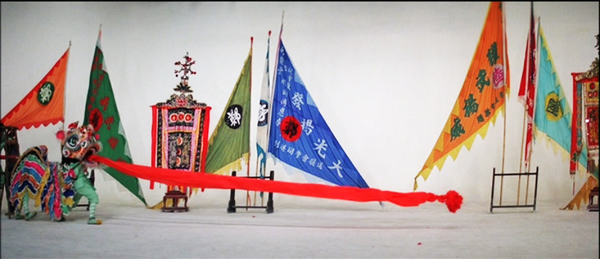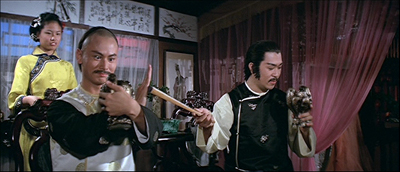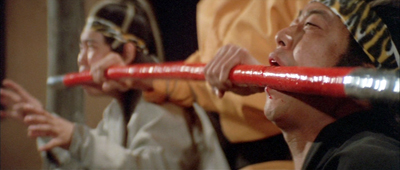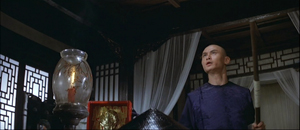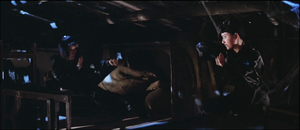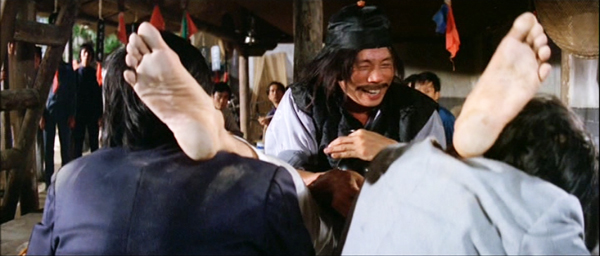Lion, dancing: Lau Kar-leung
Tuesday | July 2, 2013 open printable version
open printable version
Martial Club (1981, Lau Kar-leung).
“It’s too late. We don’t need stuntmen any more. We have computers.”
Lau Kar-leung
DB here:
Lau Kar-leung (in Mandarin: Liu Chia-liang), who died last week, was one of the best filmmakers of the 1970s and 1980s. Yet he remains largely unknown in the west.
Why? He made Hong Kong martial-arts movies, a genre long despised by upscale cinephiles. His career took off after the kung-fu boom in America and Europe had ended, so his films didn’t get wide circulation abroad. Worse, he worked for Shaw Bros., the studio decried as a soulless movie factory. (Oddly, his best films coincided with the decline of the studio’s output, as Run Run Shaw turned his attention more to television.) In Asia Lau’s films had to compete with the rising popularity of Golden Harvest’s fast, slick new films starring the Hui brothers, Sammo Hung, Yuen Biao, and Jackie Chan. And he largely missed the shift to the modern urban action picture that helped Hong Kong films into world markets in the late 1980s. Even though he made the remarkable cop movie Tiger on the Beat (1988), he never fully embraced the bloody-brotherhood ethos epitomized in the work of John Woo.
Before he became a director, Lau was a martial-arts choreographer. Credits list him on over 125 films, though he claimed to have worked on more than two hundred. He came into his own as an action choreographer in 1962, when he was about twenty-five. He worked for companies turning out both Cantonese and Mandarin martial-arts films. The film that brought him to attention was The Jade Bow (1966), made for the Great Wall company. This rattling effort, choreographed by Lau and his frequent collaborator Tong Kai, made ingenious use of wirework and reverse-motion effects.
The Jade Bow, hard and spare in its style, was strikingly similar to the new wave of martial arts films announced with great fanfare by the Shaws studios in the same year. Soon Lau became a major Shaws choreographer. Usually paired with Tong, he collaborated on many of Chang Cheh’s flamboyant, aggressive action pictures, including The Assassin (1967), One-Armed Swordsman (1967), Golden Swallow (1968), New One-Armed Swordsman (1970), Blood Brothers (1973), and Disciples of Shaolin (1975). Lau might stage fights for sixteen different releases in a single year.
Lau and Tong complemented one another. Lau grew up in a martial-arts household and learned classic technique from his father. Tong came from Cantonese opera, eventually working as a stage stuntman. To his film work Tong brought acrobatic styles and a deep knowledge of weaponry that helped him design eye-catching swords and spears. The two worked out fights together, one playing the protagonist, the other the antagonist. In 1975, Lau became a director while Tong continued to choreograph other projects.
Lau began directing just as the kung-fu boom needed something to spice it up. Bruce Lee had introduced serious, even melodramatic combat. Chang Cheh had continued in this vein while emphasizing agonizing violence, homorerotic tensions, and plots based on Shaolin temple legends. Soon Chang would innovate along a different dimension by presenting circus-like, almost camp extravaganzas centered on the Five Deadly Venoms team.
A dash, or more, of laughs
Lau’s directorial debut, The Spiritual Boxer (1975), is often considered the first kung-fu comedy, and many of his films include mugging, goofy dialogue, and physical gags. He went beyond one-off humor by finding ways to make combat itself funny. In Dirty Ho (1979) two masters maintain teatime manners while trying to thrust goblets, fans, and fingers into each other’s face (above). My Young Auntie (1981) features a demure heroine who is, to everyone’s surprise, an adept at kung-fu. Heroes of the East (1978; my preferred title: Shaolin vs. Ninja) rests entirely on a comic premise. A Chinese man marries a Japanese woman, but soon they quarrel about which nation has the stronger warrior tradition. Broken furniture follows. Even Legendary Weapons of China (1982), an attempt to present the Boxer Rebellion, can’t avoid spectacular gag scenes in which a magic doll is twisted to manipulate a fighter into grotesque positions.
Lau’s emblematic actor, as central to him as John Wayne was to Ford or James Stewart was to Anthony Mann, was Lau Kar-fai (Liu Chia-hui), familiarly known in Western circles as Gordon Liu. Sometimes bald, sometimes bearded or mustached, Liu can play hayseed, shirker, reluctant hero, con man, or elder sage. His breakout role came in one of Kar-leung’s most famous films, 36 Chambers of Shaolin (1978), which was given a comic sequel as Return to the 36th Chamber (1980). But there’s nothing funny about the ferocity of The 8-Diagram Pole Fighter (1984), which begins with a theatrically abstract representation of a battle and ends with Gordon Liu rescued by monks who bash in the teeth of their adversaries.
Lau brought to the action genre a fierce athleticism, a tireless energy—some of his films contain a dozen combats, big and small—and a thorough acquaintance with many martial-arts schools. A film might showcase one fighting style or several. At the climax of Legendary Weapons Lau himself steps in to perform virtuoso moves with a variety of spears, chain whips, daggers, swords, and staffs. Heroes of the East sets seven Japanese masters, each with a martial specialty, against our young Chinese husband, and the film provides virtually a compare-contrast essay in Asian combat tactics. Sometimes one thinks that Lau was aiming at nothing less than a filmic encyclopedia of classic martial arts, a sort of audiovisual database of the entire Chinese wuxia tradition.
This shouldn’t be taken to mean that his filming was straightforward. Lau had tremendous cinematic gifts. Staccato figure movement, often integrated with punchy zooms, give his scenes a racy, infectious pulse. Although he usually stays far enough back to capture the entire action, he cuts very fast, averaging four to five seconds, but his careful ‘Scope compositions and smooth match cuts keep the action intelligible. The frame teems with movement. A pole may jab into the foreground, and his fighters may pop up from the bottom or sides of the frame. Starting from a detail, a zoom-back can create a whooshing burst in the manner of a comic-strip splash panel. These conventions of local cinema were made especially gripping by their integration with the distinctive maneuvers of each fighting mode.
The Hong Kong tradition relies on rhythmic staging and cutting, but Lau took things further than most. Even in scenes not centered on combats, he found ways to make movements counter each other, cut for cut, or to flow from one figure to another across the scene. Motion often becomes contagious, with one man’s gesture followed by another man’s rhyming head turn or sudden twist of a torso. Fighters prowling in a darkened attic in Legendary Weapons are intercut with their target in the floor below; his abrupt gestures and pauses are echoed by theirs.
Once Lau found his stride, he seemed to make every film an experiment in rendering kung-fu’s most esoteric traditions through the resources of purely cinematic rhythm.
His most sustained output ran from 1975 to 1985, although he directed sporadically thereafter. His last directed film, Drunken Monkey (2003), failed to attract attention, but he remained the honored elder consulted by younger directors. Jackie Chan engaged him for his Drunken Master II (1994) and Tsui Hark hired him for Seven Swords (2005).
Let’s get unreal
Almost always, I tend to think, the quest for realism in cinema is misguided. Realism is often just an alibi for the brand of artifice we prefer. The great “realist” movements in cinema did access certain aspects of the world that were overlooked by other trends, but they treated those aspects through new conventions. From Soviet Socialist Realism through postwar American “semidocumentary” shooting and Method acting to Neorealism and onward, fresh forms replaced, or reworked exisiting ones. Reality is multifaceted, and any style can be said to be faithful to some facets of it.
It might be nice if our filmmakers working outside the realm of comedy acknowledged artifice more frankly. Today, watching the “realistic” action scenes of World War Z and others like it, with their choppy cutting, murky staging, and grab-and-go framing, I’m reminded not of their excuse (to render “the way characters feel”) but of their overarching purpose: to obtain a PG-13 rating. The new conventions aim to hide the action rather than display it.
That demand keeps many of today’s action films from being precisely and percussively arousing. We’re supposed to be satisfied with a vague excitement. Our films project a manic, diffuse busyness, an effort to suggest lots going on without ever specifying exactly what it feels like to run, to fall, to hit a wall, to feel a blow—in short, to face the stubborn physicality of the world. Those effects can, paradoxically enough, often be best activated by highly stylized cinema.
Consider the chainsaw climax of Lau’s Tiger on the Beat, which I’ve analyzed in an earlier entry. Even in this YouTube video, it retains a lot of its impact.
Yes, it’s over the top. Yes, it employs Hong Kong Physics. No, it wouldn’t get a PG-13. But every image and sound is focused to achieve crisp excitement. It’s very fast without being confusing. The use of film technique is cogent, inventive (how many ways to wreck a paint shop?), and stirring. And a little funny too.
It’s not realistic, but it knocks you upside the head. You either laugh or gape, but you can’t say you felt nothing. Stylization, in other words, is one path to powerful expression, and even exhilaration. Nobody understood that better than Lau Kar-leung.
On Lau Kar-leung and Tong Kai, my primary source has been A Tribute to Action Choreographers, ed. Li Cheuk-to (Hong Kong International Film Festival, 2006), 44-63. An engaging appreciation of Lau can be found in Bey Logan’s Hong Kong Action Cinema (Overlook, 1996). Logan has also provided informative commentary on many Lau films for the Dragon Dynasty DVD series. Stephen Teo discusses the sexual/ erotic side of Lau’s films in his indispensable Hong Kong Cinema (British Film Institute, 1997), 104-109. See also John Charles’ very useful Hong Kong Filmography, 1977-1997 (McFarland, 2000).
An enlightening interview with Lau is at Ric Myers’ Martial Arts in Media site.
As usual, the Hong Kong Movie Database is the primary online source for material on this wondrous cinema. Thanks to Ryan Law for building this great resource. Thanks also to Ross Chen of Lovehkfilm, a great source of news and reviews, for his many years of friendship and his dedication to the cause.
Gordon Liu (Lau Kar-fai) is often spoken of as Lau Kar-leung’s brother. Actually, they are not blood relations. Gordon was the godson of Lau’s father, and he was trained in martial arts by Lau Kar-leung. Thanks to Li Cheuk-to for help in clarifying this.
We owe a debt to Celestial Pictures, the company that acquired and remastered the classic Shaw films in mammoth quantities. Apart from the tweeting birds that seep into too many soundtracks, the restorations have been gorgeous and allow us to rediscover films that for decades were virtually impossible to see.
Several other entries on this site analyze Hong Kong filmmaking. Jackie Chan takes on James Bond here. I discuss Hong Kong’s use of anamorphic widescreen here. See also the daily series that started here and ended here. I discuss Lau Kar-leung in relation to King Hu and Chang Cheh in Planet Hong Kong 2.0.
In a related development, the new American Cinematographer (July 2013) contains an article in which Gil Hubbs, DP for Enter the Dragon (1973), provides lots of information on how that pivotal film was made. The piece is not yet available online.
Maybe just as tangential, an interview with me at last year’s FanTasia festival is on video here and transcribed here (rambling intact). Both touch on matters of martial-arts filmmaking. Thanks to David Hanley for all his work in bringing this to pass.
Of recent Hollywood action films the one I’ve seen that comes closest to the Hong Kong aesthetic is Steven Soderbergh’s Haywire.
P.S. 2 June: Thanks to Shawn McKenna for a correction!
Lau Kar-leung practicing drunken kung-fu in Heroes of the East (1978).












